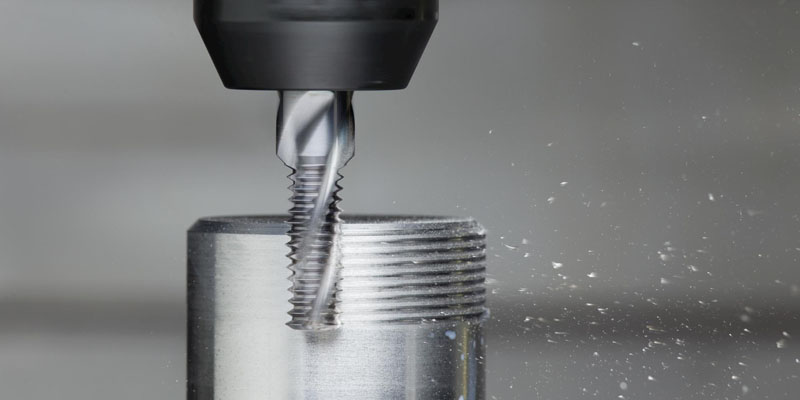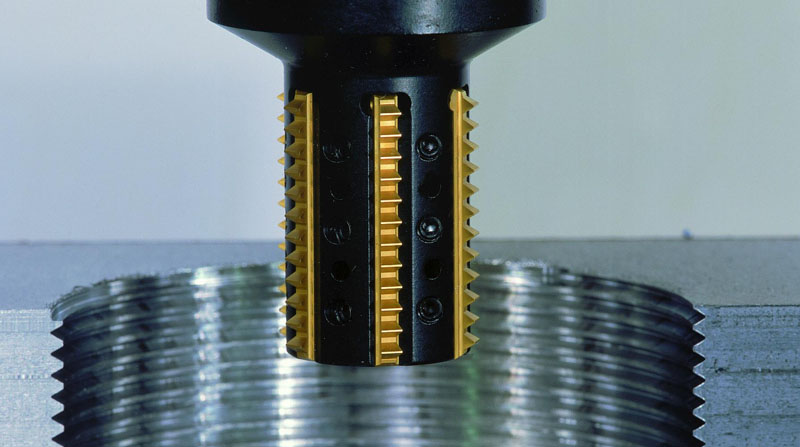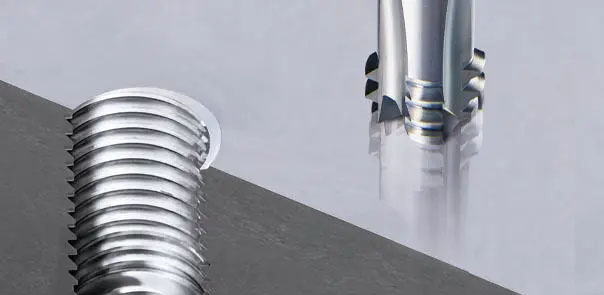Thread milling cutters have many advantages, which are more advantageous than wire taps. Thread milling cutters are more than ten times faster than wire taps and have high precision.
The surface roughness is good, and the same pitch can be used to process the large and small holes with a knife. Drilling, milling and chamfering are formed at one time. After being broken, it will not be taken out like a wire tap, and the machine tool resistance is also small.
Introduction Of Thread Milling Cutter:
The traditional thread processing methods are mainly to use thread turning tools to turn threads or use taps, dies to manually tap and buckle. With the development of numerical control processing technology, especially the emergence of three-axis linkage numerical control processing system, a more advanced thread processing method-thread numerical control milling can be realized. Compared with traditional thread processing methods, thread milling has great advantages in processing accuracy and processing efficiency, and it is not restricted by thread structure and thread rotation during processing. For example, a thread milling cutter can process a variety of different rotation directions. Internal and external threads. For the thread that does not allow transitional buckle or undercut structure, it is difficult to process with traditional turning methods or taps and dies, but it is very easy to achieve with CNC milling. In addition, the durability of thread milling cutters is more than ten times or even dozens of times that of taps, and in the process of CNC milling threads, the adjustment of the thread diameter is extremely convenient, which is difficult to achieve with taps and dies.

Milling Thread Machining Classification
Machine Clip Type:
Single-tooth machine clamp: The mechanical structure is similar to a threaded turning tool. The blade is connected to the turning tool, and there is only one thread processing tooth. The tool can only process one tooth per one spiral movement, and the corresponding pitch is reduced in the Z-axis direction. The efficiency is lower than that of the multi-tooth machine clamp thread milling cutter.
Multi-tooth machine clamp: There are multiple thread processing teeth on the blade. The tool rotates one circle, and the pitch of the corresponding number of teeth can be reduced on the Z axis to process multiple thread teeth with high processing effect.
Integral Type:
Integral type: There are also many thread processing teeth on the cutting edge. It is a fixed-pitch thread milling cutter. The cutter is made of solid carbide, which has good rigidity and can have higher cutting speed and feed speed. It has a wide processing range and structure. Compact, capable of processing small and medium diameter internal threads. But its price is more expensive.
Milling Thread Machining Characteristics
1. Stability
When processing difficult-to-machine materials such as titanium alloys, high-temperature alloys and high-hardness materials, the taps are often twisted or even broken in the parts due to too much cutting force. In the processing of long chip materials, once the chip removal is not smooth, the chips will wrap around the tap or block the orifice, often causing the tap to collapse or break in the part. Taking out the broken tap is time-consuming and laborious and may damage the parts. To solve this problem, we can use thread milling cutters. Because the thread milling cutter cuts into the material gradually, the cutting force it generates is small and the tool breaks rarely. Even in the event of a broken tool, since the diameter of the milling cutter is much smaller than that of the threaded hole, the broken part can be easily removed from the part without damaging the part.
2 High Precision
Because thread milling is done through high-speed tool rotation and spindle interpolation, it is convenient to process internal threads and remove chips. Thread milling belongs to chip-breaking cutting, and the chips are short and small. In addition, the diameter of the machining tool is larger than that of the thread to avoid the rotation line formed by the reversal of the tap (in the case of high sealing requirements, it is not allowed). Because there is no revolving line at all for processing the original milling cutter, and the tap cannot be avoided. The phenomenon of sticky chips is not easy to form. For relatively soft materials, chip sticking is prone to occur during processing, but threads require low machine power. Because thread milling is chip-breaking cutting, the tools are in local contact, the cutting force is small, and the tap tool breakage is easy to handle.
3.High Efficiency
High processing efficiency. We know that in large-volume thread processing, it is very difficult to improve processing efficiency due to the relatively low cutting speed limit of the tap and the reverse retraction after the thread is processed. However, if we use a thread milling cutter, not only its own milling speed is very high, but its multi-slot design increases the number of cutting edges so that the feed speed can be easily increased, which can greatly increase the processing efficiency. In the processing of long threads, we can also choose a blade with a longer blade to reduce the axial feed distance (equivalent to shortening the thread) to further improve the processing efficiency.

4. Good Finish
When machining with a tap, it is quite difficult to obtain a good surface finish and thread accuracy due to the influence of the lower cutting speed and difficult chip breaking. However, nothing is a problem for thread milling! High cutting speed and small cutting force make the cutting surface very smooth; fine chips can be easily flushed out of the workpiece by the coolant without scratching the machined surface. For workpieces with higher thread accuracy requirements, because thread milling cutters rely on helical interpolation to ensure accuracy, you only need to adjust the program to easily obtain the required high-precision threads. This feature has an absolute advantage in precision thread processing.
5 Low Cost
The thread milling cutter is flexible to use and can be applied to a variety of working conditions. For example: we can use the same thread milling cutter to machine left-hand threads or right-hand threads; we can machine both external threads and internal threads. All of this only needs to adjust the interpolation procedure. Using taps for machining, if there are multiple threaded holes with different diameters but the same pitch on the part, taps of different diameters are required.
This not only requires a lot of taps, but also requires a lot of tool change time. If a thread milling cutter is used, since it is processed by spiral interpolation, it is only necessary to change the processing program to complete the processing of threads of all diameters, which greatly saves tool costs and tool change time.
In order to ensure thread accuracy, different types of taps need to be used when processing different materials with taps. However, there is no such restriction when using thread milling cutters. The same thread milling cutter can process most materials and obtain very high-precision threads. This can also greatly reduce tool costs.

When the thread processing requires close to the bottom of the blind hole, it will be difficult to obtain a complete thread at the bottom if tapping is used. And it is possible that the tool continues to move forward a little distance (floating tapping) during the time that the tap stops at the bottom and prepares to reverse and retreat, which will easily cause the tap to break. This problem can be avoided by using a thread milling cutter-the thread milling cutter is smaller than the hole and does not need to be reversed and retracted, and the thread shape is still intact at the tip of the tool. In this way we can obtain a complete and accurate thread depth! In some processing, thread milling can help us solve many problems.
For example: In the thread processing of large, non-circular parts, complex clamping and balancing are required to avoid vibration if processed on a lathe. At this time, it can be processed on the machining center, the parts do not move, and the thread milling cutter rotates to avoid balance problems. For example, when processing intermittent threads, the impact of vibration has a great influence on the blade and it is easy to produce cracks. The use of thread milling cutters, because the cutter is gradually cut into the material discontinuity, so that large impacts are avoided and the life of the cutter is prolonged.


